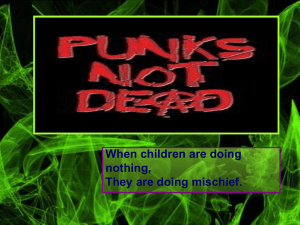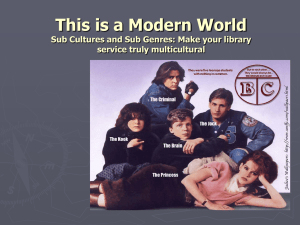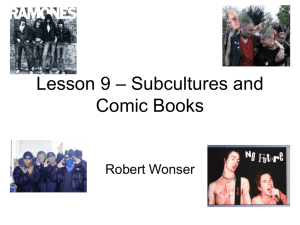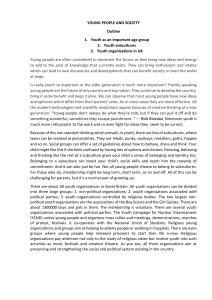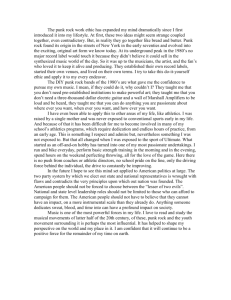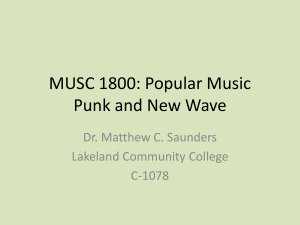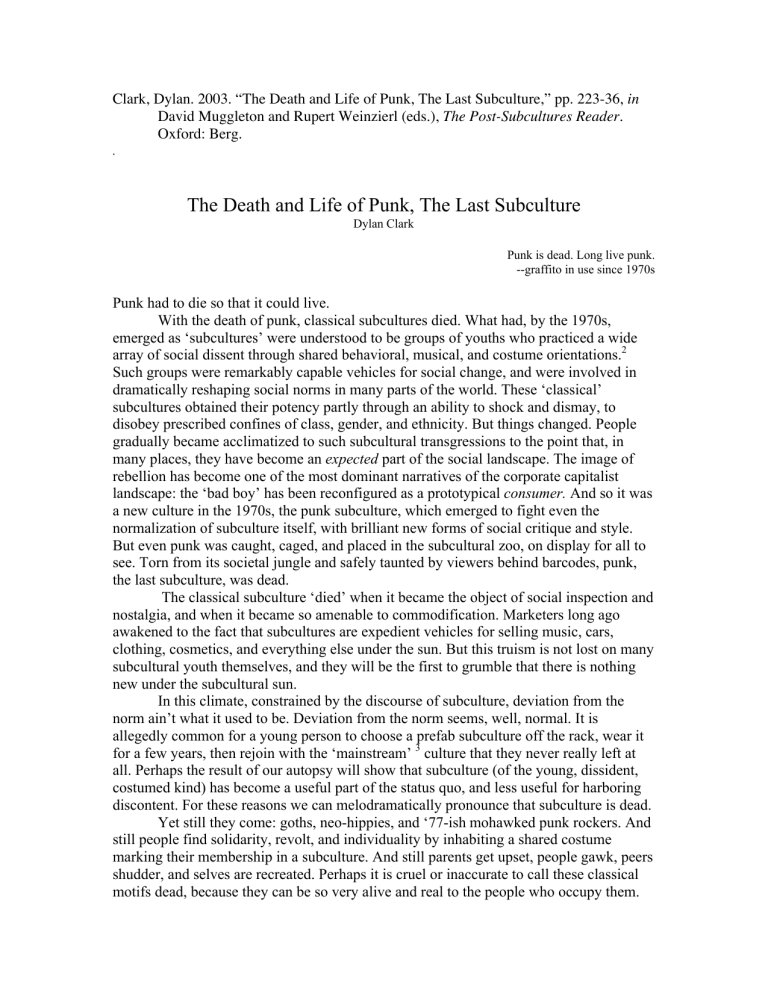
Clark, Dylan. 2003. “The Death and Life of Punk, The Last Subculture,” pp. 223-36, in David Muggleton and Rupert Weinzierl (eds.), The Post-Subcultures Reader. Oxford: Berg. . The Death and Life of Punk, The Last Subculture Dylan Clark Punk is dead. Long live punk. --graffito in use since 1970s Punk had to die so that it could live. With the death of punk, classical subcultures died. What had, by the 1970s, emerged as ‘subcultures’ were understood to be groups of youths who practiced a wide array of social dissent through shared behavioral, musical, and costume orientations.2 Such groups were remarkably capable vehicles for social change, and were involved in dramatically reshaping social norms in many parts of the world. These ‘classical’ subcultures obtained their potency partly through an ability to shock and dismay, to disobey prescribed confines of class, gender, and ethnicity. But things changed. People gradually became acclimatized to such subcultural transgressions to the point that, in many places, they have become an expected part of the social landscape. The image of rebellion has become one of the most dominant narratives of the corporate capitalist landscape: the ‘bad boy’ has been reconfigured as a prototypical consumer. And so it was a new culture in the 1970s, the punk subculture, which emerged to fight even the normalization of subculture itself, with brilliant new forms of social critique and style. But even punk was caught, caged, and placed in the subcultural zoo, on display for all to see. Torn from its societal jungle and safely taunted by viewers behind barcodes, punk, the last subculture, was dead. The classical subculture ‘died’ when it became the object of social inspection and nostalgia, and when it became so amenable to commodification. Marketers long ago awakened to the fact that subcultures are expedient vehicles for selling music, cars, clothing, cosmetics, and everything else under the sun. But this truism is not lost on many subcultural youth themselves, and they will be the first to grumble that there is nothing new under the subcultural sun. In this climate, constrained by the discourse of subculture, deviation from the norm ain’t what it used to be. Deviation from the norm seems, well, normal. It is allegedly common for a young person to choose a prefab subculture off the rack, wear it for a few years, then rejoin with the ‘mainstream’ 3 culture that they never really left at all. Perhaps the result of our autopsy will show that subculture (of the young, dissident, costumed kind) has become a useful part of the status quo, and less useful for harboring discontent. For these reasons we can melodramatically pronounce that subculture is dead. Yet still they come: goths, neo-hippies, and ‘77-ish mohawked punk rockers. And still people find solidarity, revolt, and individuality by inhabiting a shared costume marking their membership in a subculture. And still parents get upset, people gawk, peers shudder, and selves are recreated. Perhaps it is cruel or inaccurate to call these classical motifs dead, because they can be so very alive and real to the people who occupy them. Like squatters in abandoned buildings, practicing subcultists give life to what seem to be deceased structures. Or is subculture dead? The death of subculture - that is, the death of subcultural autonomy and meaningful rebellion - did not escape the notice of many. For decades people have decried the commercialization of style, the paisley without the politics. But such laments have not failed to produce strategies. There is something else - another kind of subculture, gestating and growing far below the classical subcultural terrain. For two decades a secret was kept by thousands: punk never died. Instead, punk had, even in its earliest days, begun to articulate a social form which anticipates and outmaneuvers the dominance of corporate-capitalism. And as the Cold War finally disappears from decades of habit, and as the political and cultural hegemony of corporate-capitalism seems unrivaled, it suddenly becomes clear that the anarchist frameworks of punk have spread into all sorts of social groupings. The social forms punks began to play with in the early 1970s have penetrated subcultures across the spectrum. After the death of the classical subculture we witness the birth of new practices, ideologies, and ways of being - a vast litter of anarchism. For tribes of contemporary people who might be called punk (and who often refuse to label themselves), their subculture is partly in revolt from the popular discourse of subculture, from what has become, in punk eyes, a commercialized form of safe, affected discontent - a series of consumed subjectivities, including pre-fabricated ‘Alternative’ looks. Punk is, ironically, a subculture operating within parts of that established discourse, and yet it is also subculture partly dedicated to opposing what the discourse of subculture has become. As the century rolls over, punk is the invention of not just new subjectivities but, perhaps, a new kind of cultural formation. The death of subculture has in some ways helped to produce one of the most formidable subcultures yet: the death of subculture is the (re)birth of punk. Part I. Classical Punk: The Last Subculture Consumer voyeurism is much more offensive to punk sensibilities than song themes about addiction or slaughtering dolls onstage (Van Dorston 1990). At the heart of early punk was calculated anger. It was anger at the establishment and anger at the allegedly soft rebellion of the hippie counterculture; anger, too, at the commodification of rock and roll (Cullen 1996: 249). Its politics were avowedly apolitical, yet it openly and explicitly confronted the traditions and norms of the powersthat-be. Describing the cultural milieu for young people in 1975, Greil Marcus notes the centrality of cultural production: ‘For the young everything flowed from rock ‘n’ roll (fashion, slang, sexual styles, drug habits, poses), or was organized by it, or was validated by it’ (Marcus 1989: 53). But by the early 1970s, with commodification in full swing, with some artists said to have compromised their integrity by becoming rich stars, and with ‘rock’ having been integrated into the mainstream, some people felt that youth subcultures were increasingly a part of the intensifying consumer society, rather than opponents of the mainstream. Punk promised to build a scene which could not be taken. Its anger, pleasures, and ugliness were to go beyond what capitalism and bourgeois society could swallow. It would be untouchable, undesirable, unmanageable. Early punk was a proclamation and an embrace of discord. In England it was begun by working-class youths decrying a declining economy and rising unemployment, chiding the hypocrisy of the rich, and refuting the notion of reform. In America, early punk was a middle-class youth movement, a reaction against the boredom of mainstream culture (Henry 1989: 69). Early punk sought to tear apart consumer goods, royalty, and sociability; and it sought to destroy the idols of the bourgeoisie. At first punk succeeded beyond its own lurid dreams. The Sex Pistols created a fresh moral panic fueled by British tabloids, Members of Parliament, and plenty of everyday folk. Initially, at least, they threatened ‘everything England stands for’: patriotism, class hierarchy, ‘common decency,’ and ‘good taste.’ When the Sex Pistols topped the charts in Britain, and climbed high in America, Canada, and elsewhere, punk savored a moment in the sun: every public castigation only convinced more people that punk was real. Damning God and the state, work and leisure, home and family, sex and play, the audience and itself, the music briefly made it possible to experience all those things as if they were not natural facts but ideological constructs: things than had been made and therefore could be altered, or done away with altogether. It became possible to see these things as bad jokes, and for the music to come forth as a better joke (Marcus 1989: 6). Punk was to cross the rubicon of style from which there could be no retreat. Some punks went so far as to valorize anything mainstream society disliked, including rape and death camps; some punks slid into fascism. When the raw forces and ugliness of punk succumbed to corporate-capitalism within a few short years, the music/style nexus had lost its battle of Waterloo. Punk waged an all-out battle on this front, and it wielded new and shocking armaments, but in the end, even punk was proven profitable. Penny Rimbaud traces its cooptation: ‘within six months the movement had been bought out. The capitalist counter-revolutionaries had killed with cash. Punk degenerated from being a force for change, to becoming just another element in the grand media circus. Sold out, sanitised and strangled, punk had become just another social commodity, a burnt-out memory of how it might have been (1998: 74).4 Profits serve to bandage the wounds inflicted by subcultures, while time and nostalgia cover over the historical scars. Even punk, when reduced to a neat mohawk hairstyle and a studded leather jacket, could be made into a cleaned-up spokesman for potato chips. Suddenly, the language of punk was rendered meaningless. Or perhaps – perhaps - the meaningless language of punk was made meaningful. Greil Marcus (1989: 438) records the collapse of punk transgression: ‘the times changed, the context in which all these things could communicate not pedantry but novelty vanished, and what once were metaphors became fugitive footnotes to a text no longer in print.’ Like their subcultural predecessors, early punks were too dependent on music and fashion as modes for expression; these proved to be easy targets for corporate coöptation. ‘The English punk rock rhetoric of revolution, destruction, and anarchy was articulated by means of specific pleasures of consumption requiring the full industrial operations that were ostensibly were the objects of critique’ (Shank 1994: 94). Tactically speaking, the decisive subcultural advantage in music and style - their innovation, rebellion, and capacity to alarm - was preempted by the new culture industry, which mass-produced and sterilized punk’s verve. With the collapse of punk’s stylistic ultimatum, what had been the foundations for twentieth-century subcultural dissent were diminished - not lost, but never to completely recover the power they once had in music and style. Part II. The Triumph of the Culture Industry Gil Scott Heron is famous for the line, “The Revolution will not be televised.” But in a way the opposite has happened. Nothing’s given the change to brew and develop anymore, before the media takes hold of it and grinds it to death. Also, there’s an instant commodification of everything that might develop into something ‘revolutionary.’ —Dishwasher Pete (quoted in Vale 1997:17) Having ostensibly neutralized early punk, the culture industry proved itself capable of marketing any classical youth subculture. All styles, musics, and poses could be packaged: seemingly no subculture was immune to its gaze. So leveled, classical subcultures were deprived of some of their ability to generate meaning and voice critique. ‘Subculture,’ in the discourse handed down to the present, has come to popularly represent youths who adorn themselves in tribal makeup and listen to narrow genres of music. Subcultures are, in this hegemonic caricature, a temporary phase through which mostly juvenile, mostly ‘White,’ and mostly harmless people symbolically create identity and peer-groups, only to later return, as adults, to their pre-ordained roles in mainstream society. The aforementioned idea of subculture is not without merit: it is often a temporary vehicle through which teens and young adults select a somewhat prefabricated identification, make friends, separate from their parents, and individuate themselves. As a social form, this classical breed of subculture is important, widespread, and diversely expressed. In this form ‘subculture’ is partly a response to prevailing political economies and partly a cultural pattern which has been shaped and reworked by subcultures themselves and by the mass media. As such it is an inherited social form, and one which is heavily interactive with capitalist enterprise. Thus, subculture is both a discourse which continues to be a meaningful tool for countless people and, at the same time, something of a pawn of the culture industry. With its capacity to designate all subcultures, all youth, under a smooth frosting of sameness, the culture industry was capable of violating the dignity of subcultists and softening their critique. Implied in the culture industry’s appropriation of subcultural imagery was the accusation of sameness, of predictability, of a generic ‘kids will be kids.’ To paste on any group a label of synchronic oneness, is to in some way echo colonial tactics. ‘Youths’ or ‘kids,’ when smothered with a pan-generational moment of discontent, are reduced to a mere footnote to the dominant narrative of corporatecapitalism. Trapped in nostalgia and commercial classifications, subcultures and youth are merged into the endless, amalgamated consumer culture. No wonder, then, that subcultural styles no longer provoke panics, except in select small towns. Piercings and tattoos might get their owner rejected from a job, but they generally fail to arouse astonishment or fear.4 Writes Frederic Jameson (1983: 124): ‘…there is very little in either the form of the content of contemporary art that contemporary society finds intolerable and scandalous. The most offensive forms of this art--punk rock, say… are all taken in stride by society.’ So too, ideas of self-gratification are no longer at odds with the status quo. In the ‘Just Do It’ culture of the late-twentieth century, selfish hedonism dominates the airwaves. Says Simon Reynolds: ‘“Youth” has been co-opted, in a sanitized, censored version... Desire is no longer antagonistic to materialism, as it was circa the Stones’ “Satisfaction”’. Instead young people often relate to the alienation of The Smiths or R.E.M., who seem to lament that ‘everyone is having fun except me;’ the sense of failure at not having the ‘sex/fun/style’ of the young people in the mass media (1988: 254). Indeed, long before ‘satisfaction’ became hegemonic the commodity promised to satisfy. But because it cannot satisfy it leaves a melancholy satisfiable only in further consumption. So notes Stacy Corngold who concludes that ‘Gramsci’s general point appears to have been confirmed: all complex industrial societies rule by non-coercive coercion, whereby political questions become disguised as cultural ones and as such become insoluble’ (1996: 33). Youth subcultures, after the triumph of the culture industry, may perpetually find themselves one commodity short of satisfaction, and trapped by words that were once libratory. Or, as Grant McCracken (1988: 133) argues, commodities cannot be completely effective as a mode of dissent because they are made legible in a language written by corporate-capitalism. As he writes: ‘when “hippies,” “punks”, “gays”, “feminists”, “young republicans”, and other radical groups use consumer goods to declare their difference, the code they use renders them comprehensible to the rest of society and assimilable within a larger set of cultural categories. ...The act of protest is finally an act of participation in a set of shared symbols and meanings’. Though McCracken underestimates the efficacy of stylized dissent, he is able to locate a defining weakness in the emphasis that subcultures have historically placed in style. My contention is that style was far more potent as a mode of rebellion in the past, and that not until the demise of punk was subcultural style dealt a mortal wound. After the demise of punk’s über-style, after a kind of terminal point for outrageousness, there is a banality to subcultural style. And it is for this reason that Dick Hebdige’s (1979: 102) ‘communication of a significant difference’ can no longer serve as a cornerstone in the masonry of subcultural identity.6 Following this logic, George McKay (1998: 20) comments on ‘Ecstasy Industry’ of mass culture, which has seized control of style. Thus, ‘the Ecstasy Industry, for its part, is doing only too well under contemporary capitalism and could easily absorb the techniques of lifestyle anarchists to enhance a marketably naughty image. The counterculture that once shocked the bourgeoisie with its long hair, beards, dress, sexual freedom, and art has long since been upstaged by bourgeois entrepreneurs’. We can say, too, that the economy for subcultural codes suffers from hyperinflation. In other words, the value of subcultural signs and meanings has been depleted: an unusual hairstyle just can’t buy the outsider status it used to. Stylistic transgressions are sometimes piled on one another like so many pesos, but the value slips away almost instantly. Thus, by the 1990s, dissident youth subcultures were far less able to arouse moral panics (Boëthius 1995: 52) despite an accelerated pace of style innovation (Ferrell 1993: 194). In the 2000s, subcultural style is worth less because a succession of subcultures has been commodified in past decades. ‘Subculture’ has become a billion dollar industry. Bare skin, odd piercings, and bluejeans are not a source of moral panics these days: they often help to create new market opportunities. Even irony, indifference, and apathy toward styles and subculture have been incorporated into Sprite and OK Cola commercials: every subjectivity, or so it may seem, has been swallowed up by the gluttons of Madison Avenue (Frank 1996, 1997a, 1997b). Part III. The Discourse of Subculture, Plain for All to See ‘We burrow and borrow and barrow (or dump) our trash and treasures in an endless ballet of making and unmaking and remaking. The speed of this process is now such that a child can see it’ (McLuhan and Nevitt 1972: 104-5). The patterned quality of youth subculture (innovate style and musicobtain a followingbecome commodified and typecast) forms a discourse of subculture, one that is recognized by academics and youths alike. That such a discourse is identifiable over several decades, however, does not mean that it goes unchanged or unchallenged. As a social form it undergoes change in its own right, but also because it has become the discursive object of the mass media. In particular, ‘subculture’ has been in many ways incorporated as a set trope of the culture industries which retail entertainment, clothing, and other commodities. Many observers - academics, journalists, and culture industrialists - fail to recognize that hegemonic appropriation of the discourse of subculture has had impacts for the people in subcultures. Observers may fall into a classic pitfall, wherein they typecast subcultures. Any number of scholars are guilty of detailing the patterned quality of the discourse of subculture, trapping subcultures in a kind of synchronic Othering.7 One example should suffice: Nowhere is the rapidly cyclical nature of rock-and-roll history more evident than in the series of events surrounding punk rock. Punk broke all the rules and declared war on all previously existing musical trends and rules of social behavior. Rebelling against established musical trends and social mores, punk quickly became a tradition in itself - a movement with highly predictable stylistic elements. By 1981, just six years after the formation of the Sex Pistols, a new generation of performers had already begun to assert an identity distinct from the established punk style. … Here we come full circle in the evolution of rock-and-roll as seen through the lens of punk. Emerging as the antithesis of the conservative musical climate of the 1970s, punk was quickly absorbed and exploited by the very elements against which it rebelled. Undoubtedly a new generation of performers will soon find an aesthetic and philosophical means of rebelling against the now commercial state of rock, just as punks did in [the 1970s] (Henry 1989: 115, 116). Henry, like so many other commentators, repeats serious errors in subcultural studies: (1) she conflates well-known musicians with the subcultures that listen to them; (2) rather than engage punk on its own terms she reduces punk to a type of youth subculture and little more; (3) she assumes that the ‘cyclical nature of rock-and-roll’ will continue to cycle, without considering the cultural effects of its repeated rotations. Many witnesses fail to see the dialectical motion of the discourse of subculture. Indeed, commodification and trivialization of subcultural style is becoming ever more rapid and, at the turn of the millennium, subcultures are losing certain powers of speech. Part of what has become the hegemonic discourse of subculture is a misrepresentative depolitization of subcultures; the notion that subcultures were and are little more than hairstyles, quaint slang, and pop songs. In the prism of nostalgia, the politics and ideologies of subcultures are often stripped from them. For today’s subcultural practitioners what does it mean when subcultures of the previous decades are encapsulated in commercials and nostalgia? Punks, mods, hippies, break dancers, 70s stoners: all seem relegated to cages in the zoo of history, viewed and laughed at from the smug security of a television monitor. (The sign says, ‘Please do not taunt the historical subcultures’, but who listens?) Today’s subcultural denizens are forced to recognize that yesterday’s subcultures can quite easily be repackaged, made spokeswomen for the new Volkswagen. One danger industrial pop culture poses to subsequent generations of dissident youth subcultures is that these youths may mistake style as the totality of prior dissent. Commercial culture deprives subcultures of a voice when it succeeds in linking subcultural style to its own products, when it nostalgizes and trivializes historical subcultures, and when it reduces a subculture to just another consumer preference. People within subcultures, for their part, capitulate when they equate commodified style with coöptation, when they believe that grunge, or punk, or break-dancing, is just another way of choosing Pepsi over Coke, when they believe that the entirety of subculture is shallow or stolen. Dissident youth subculture is normal and expected, even unwittingly hegemonic. Where long hair and denim once threatened the mainstream, it has become mainstream and so has the very idea of subculture. Not only are deviant styles normalized, but subcultural presence is now taken for granted: the fact of subcultures is accepted and anticipated. Subcultures may even serve a useful function for capitalism, by making stylistic innovations which can then become vehicles for new sales. Subcultures became, by the 1970s, if not earlier, a part of everyday life, another category of people in the goings-on of society - part of the landscape, part of daily life, part of hegemonic normality. But this fact did not go unnoticed by many people in the subcultural world. Part IV. Long Live Punk: New Ways of Being Subcultural Looking back at the 1980s one has to ask whether punk really died at all. Perhaps the death of punk symbolically transpired with the elections of Margaret Thatcher in England (1979) and Ronald Reagan in America (1980). The Sex Pistols broke up (1978), Sid Vicious died (1979), and - most damningly - too many teeny boppers were affecting a safe, suburban version of ‘punk.’ For many people, spiked hair and dog collars had become a joke, the domain of soda pop ads and teevee dramas. But did punk disappear with the utter sell-out of its foremost corporate spokesband, the Sex Pistols? Did punk vanish when pink mohawks could be found only on pubescent heads at the shopping mall? If the spectacular collapse of punk was also the collapse of spectacular subcultures, what remained after the inferno? What crawled from the wreckage? In what ways can young people express their unease with the modern structure of feeling? A new kind of punk has been answering these questions. After shedding its dog collars and Union Jacks, punk came to be: (1) an antimodern articulation, and (2) a way of being subcultural while addressing the discursive problems of subcultures. In fact, these two courses prove to be one path. That is, the problems of contemporary punk subcultures, after the ‘death’ of classical subcultures, prove to be intimate with the characteristics of recent modernity. Punk, then, is a position from which to articulate an ideological position without accruing the film of mainstream attention. Contemporary punk subcultures, may therefore choose to avoid spectacle-based interaction with dominant culture. Gone too is the dream of toppling the status quo in subcultural revolution. The culture industry not only proved louder than any subcultural challenge, it was a skilled predator on the prowl for fresh young subcultures. The power to directly confront dominant society was lost also with the increasing speed with which the commodification of deviant styles is achieved. It may be only a matter of months between stylistic innovation and its autonomous language of outsider-ness, and its representation in commercials and shopping malls. Even the un-style of 1990s grunge (an old pair of jeans and a flannel shirt) was converted to the religion of the consumer; baptized and born-again as celebrations of corporate-capitalism. With such history in mind, new social movements such as punk attempt to forego style, shared music, and even names for themselves, for fear of being coöpted by the market democracy. Tom Frank, speaking at a convention of zinesters addressed precisely this aspect of the structure of feeling in the 1990s: The real thing to do is get some content. If you don’t want to be coöpted, if you don’t want to be ripped off, there’s only one thing that’s ever going to prevent it and that’s politics. National politics, politics of the workplace, but most importantly politics of culture. Which means getting a clue about what the Culture Trust does and why, and saying what needs to be said about it. As culture is becoming the central pillar of our national economy, the politics of culture are becoming ever more central to the way our lives are played out. Realize that what the Culture Trust is doing is the greatest obscenity, the most arrogant reworking of people’s lives to come down the pike in a hundred years. Be clear from the start: what we’re doing isn’t a subculture; it’s an adversarial culture (Frank 1996). To a certain extent, punk means post-punk - a nameless, covert subculture reformed after punk. To recap: early punk was, in part, simulated ‘anarchy;’ the performance of an unruly mob. So long as it could convince or alarm straight people, it achieved the enactment. For its play to work, punk needed a perplexed and frightened ‘mainstream’ off which to bounce. But when the mainstream proved that it needed punk, punk’s equation was reversed: its negativity became positively commercial. As mainstream style diversified, and as deviant styles were normalized, punk had less to act against. Punk had gambled all its chips on public outcry, and when it could no longer captivate an audience, it was wiped clean. Post-punk, or contemporary punk, has foregone these performances of anarchy and is now almost synonymous with the practice of anarchism. Long after the ‘death’ of classical punk, post-punk and/or punk subcultures coalesce around praxis. For contemporary punks subcultural membership, authenticity, and prestige are transacted through action internal to the subculture. Greil Marcus’ idea of punk’s greatness is that the Sex Pistols could tell Bill Grundy to ‘fuck off’ on television. The real greatness of punk is that it can develop an entire subculture that would tell Bill Grundy and safe, boring television culture as a whole to fuck off directly, establishing a parallel social reality to that of boring consumerism (Van Dorston 1990).8 Stripped nude, ideologies developed in the early years of punk continue to provide frameworks for meaningful subculture. Against the threatening purview of mass media and its capacity to usurp and commodify style, punk subcultures steer away from symbolic encounters with the System and create a basis in experience. Punks, in my work among the anarchist-punks of Seattle, don’t call themselves punks. Instead they obliquely refer to the scene in which they ‘hang out.’ They deny that they have rules, and claim that they are socially and ideologically porous. After three decades, here is what has become of many of the CCCS’ spectacular subcultures. And yet, in their stead, vibrant, living subcultures remain, with sets of regulations, norms, and their own ideological turfs. Seattle’s anarchist-punks, for example, disavow an orthodox name, costume, or music; yet in many ways they continue to live, or perhaps squat, within the classical structure of subculture. Although today’s punks refuse to pay the spectacular rent, they find that a new breed of subculture offers them ideological shelter and warmth. From whence did these latter-day punks come? In contemporary America, the relentless commodification of subcultures has brought about a crisis in the act of subcultural signification. Punk is today, in part, a careful articulation in response to the hyper-inflationary market for subcultural codes and meanings, an evasion of subcultural commodification, and a protest against prefabricated culture; and punk is a subculture which resists the hegemonic discourse of subculture. The public coöptation of punk has led some punks to disclaim early punk, while preserving its more political features. Having been forced, as it were, out of a costume and music-based clique, punk is evolving into one of the most powerful political forces in North America and Europe, making its presence felt in the Battle of Seattle (1999), Quebec City (2001), EarthFirst!, Reclaim the Streets, and in variety of anti-corporate movements. Like the spectacular subcultures so aptly described by the CCCS in the 1970s, current punks are partly in pursuit of an authentic existence. However, now that stylistic authenticity has been problematized by the ‘conquest of cool’ (Frank 1997), punks have found that the ultimate authenticity lies in political action. Where subcultures were once a steady source of freshly marketable styles for corporations, they now present corporations with a formidable opponent. Punk marks a terrain in which people steadfastly challenge urban sprawl, war, vivisection, deforestation, racism, the exploitation of the third world, and many other manifestations of corporate-capitalism. The threatening pose has been replaced with the actual threat. Perhaps that is one of the great secrets of subcultural history: punk faked its own death. Gone was the hair, gone was the boutique clothing, gone was negative rebellion (whatever they do, we’ll do the opposite). Gone was the name. Maybe it had to die, so as to collect its own life insurance. When punk was pronounced dead it bequeathed to its successors - to itself - a new subcultural discourse. The do-it-yourself culture had spawned independent record labels, speciality record stores, and music venues: in these places culture could be produced with less capitalism, more autonomy, and more anonymity. Punk faked its own death so well that everyone believed it. Many people who were still, in essence, punk did not know that they were inhabiting kinds of punk subjectivity. Even today, many people engaged in what might be called punk think of punk only in terms of its classical archetype. Punk can be hidden even to itself. Punk had to die so that it could live. By slipping free of its orthodoxies - its costumes, musical regulations, behaviors, and thoughts - punk embodied the anarchism it aspired to. Decentralized, anti-hierarchical, mobile, and invisible, punk has become a loose assemblage of guerrilla militias. It cannot be owned, it cannot be sold. It upholds the principles of anarchism, yet is has no ideology. It is called punk, yet it has no name. Notes 1. Many sentences and ideas here first appeared in Clark (2000), and were presented at the unforgettable No-Future conference, Wolverhampton, England, 2001. 2. Though subculture has far broader meanings, it has come to signify the twentiethcentury category for youth groups who possess some sort of marked style and shared affiliations. And while sociologists use the term to describe an infinitely wider array of groups - sport fishermen, West Texas Baptists, or toy train hobbyists - ‘subculture’ is more popularly used to characterize groups of young people. From the flappers of the 1920s to the Chicano cholos of the 1970s, ‘subculture’ is above all a container which attempts to hold various groups of young people whose affect, clothing, music, and norms, deviate from a mythological center. That these subcultures are often ‘White’ in their ethnic composition is regularly unmarked in academic discussions, despite its enormous import. I should add that my research focuses on the United States, though people from many nations may recognize similar trends. 3. ‘Mainstream’ is used to denote an imaginary hegemonic center of corporatized culture. It is used here as it is used by many people in dissident subcultures: to denote hegemonic culture. It is, in this sense, an archetype, rather than something with a precise location and character. It serves to conveniently outline a dominant culture for purposes of cultural critique and identity formation. 4. Penny Rimbaud is one of the founding members of Crass, an English punk band that helped to revitalize, de-stylize, organize, and politicize punk in the 1980s. In some ways latter-day punk is a direct outcome of the movement led by Crass and other self-described ‘anarcho-punks.’ 5. Subcultures arouse no fear, that is, so long as their members are ‘White.’ ‘Gangs,’ a term which often refers to any gathering of young brown-skinned people (especially boys and young men) can frighten, alarm, and threaten straight society. The danger sometimes associated with non-White youth is the last vestige of subcultural fear. And that is one reason why ‘White’ youths are increasingly following the subcultural lead of their ‘Black’ agemates, and consuming and affecting what they believe to be is ‘Black’ culture. 6. At the time of the publication of Hebdige’s important book, I am arguing, the publicly symbolic expression of difference was easier to achieve. 7. See Fabian (1983). 8. Van Dorston is responding to Marcus (1989). Penny Rimbaud (1998: 79) makes much the same point: ‘The pundits who now claim that punk grew out of bands like the New York Dolls, and then found its true expression in the Sex Pistols, have totally missed the point… The bands were secondary to an attitude, an attitude born on the street rather than manufactured in Tin Pan Alley.’ Bibliography Boëthius, U. (1995), ‘Youth, the Media and Moral Panics’, in J. Fornäs and G. Bolin (eds.), Youth Culture in Late Modernity, London: Sage. Clark, D. (2000), Dancing on the Ruins: Anarchy and Subculture. Doctoral Dissertation, University of Washington, Anthropology. Corngold, S. (1996), ‘The Melancholy Object of Consumption,’ in R. Bogue and M. Cornis-Pope, (eds), Violence and Mediation in Contemporary Culture, Albany, NY: State of New York Press. Cullen, J. (1996), The Art of Democracy: A Concise History of Popular Culture in the United States, New York: Monthly Review Press. Fabian, J. (1983), Time and the Other: How Anthropology Makes its Object, New York: Columbia University Press. Ferrell, J. (1993) Crimes of Style: Urban Graffiti and the Politics of Criminality. NY: Garland Publishing. Frank, T. (1996), ‘Zines and the Global Economy,’ talk given and tape recorded at the Center of Contemporary Art, Seattle, WA, 13 January 1996. Frank, T. (1997a), The Conquest of Cool: Business Culture, Counterculture, and the Rise of Hip Consumerism, Chicago, IL: University of Chicago Press. Frank, T. (1997b), (Untitled). Talk and book reading for The Conquest of Cool, from personal tape recording, Left Bank Books, Seattle, WA. Hebdige, D. (1979), Subculture: The Meaning of Style, New York: Routledge. Henry, T. (1989), Break All Rules! Punk Rock and the Making of a Style, Ann Arbor, MI: UMI Research Press. Jameson, F. (1983), ‘Postmodernism and Consumer Society’ in H. Foster (ed.) The AntiAesthetic: Essays on Postmodern Culture. Seattle, WA: Bay Press. Marcus, G. (1989), Lipstick Traces: A Secret History of the Twentieth Century, Cambridge, MA: Harvard University Press. McCracken, G. (1988), Culture and Consumption: New Approaches to the Symbolic Character of Consumer Goods and Activities, Bloomington and Indianapolis, IN: Indiana University Press. McKay, G. (1998), DiY Culture: Party & Protest in Nineties Britain, New York: Verso. McLuhan, M, and Nevitt, B. (1972), Take Today: The Executive as Dropout, New York: Harcourt Brace Jovanovich. O’Hara, C. (1999), The Philosophy of Punk. 2nd edition, San Francisco, CA: AK Press. Reynolds, S. (1988), ‘Against Health and Efficiency: Independent Music in the 1980s’, in A. McRobbie (ed.), Zoot Suits and Second-Hand Dresses: an Anthology of Fashion and Music, Boston, MA: Unwin Hyman. Rimbaud, P. (1998), Shibboleth - My Revolting Life, San Francisco, CA: AK Press. Shank, B. (1994), Dissonant Identities: The Rock’N’Roll Scene in Austin, Texas, Hanover, NH: Wesleyan University Press. Vale, V. (ed.) (1997), Zines! Vol II. San Francisco: V/Search Publications. Van Dorston, A. S. (1990/2001), ‘A History of Punk.’ Fast N’ Bulbous Music Webzine, <http://www.fastnbulbous.com/punk.htm>(Accessed September 2002)
